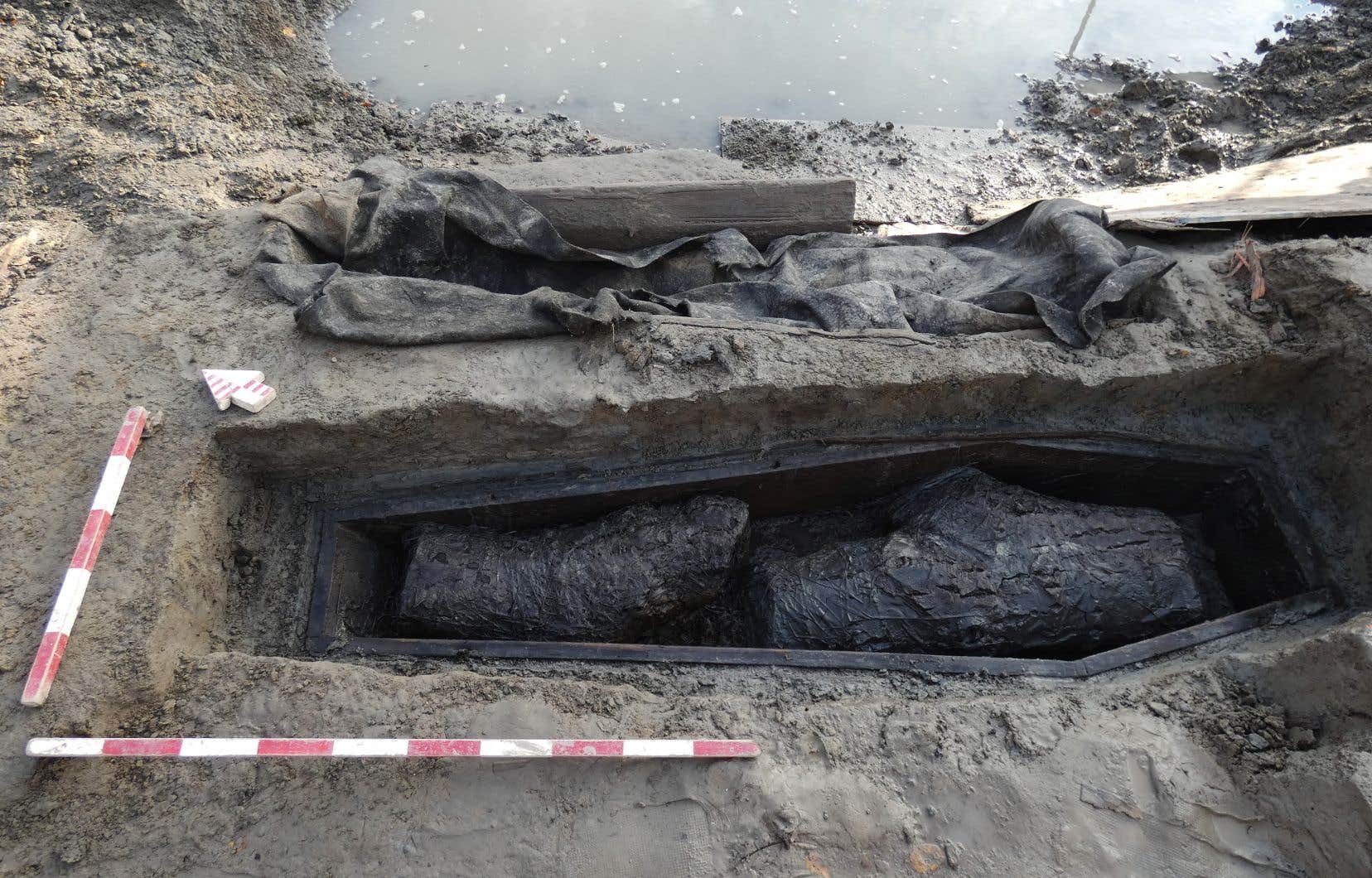Archaeological excavations carried out in an old cemetery in Faubourg Saint-Roch, in Quebec, have documented a little-known practice of 19th century medicine.e century: the theft of corpses for the purposes of dissection.
The discovery caused astonishment! By opening one of the coffins exhumed at Pointe aux Lièvres, archaeologists found two large logs weighing a total of 85 pounds. “There was not the slightest bony element of the skeleton,” indicates the report from the firm Truelle et Cie, of which The duty got a copy. “The pieces of wood were heavy enough to lead the pallbearers to believe that there was indeed a corpse in the coffin. »
The logs rested on a bed of hay so that they would not move during the funeral procession. “Unfortunately, this anonymous deceased will remain anonymous forever since his body undoubtedly ended up on a dissection table,” we read in the report dated 2022. The theft of the corpse preceded the burial of the hexagonal-shaped coffin, whose white pine cover was still nailed.
The skeleton of a child was also said to have been stolen by medical students in the 19th century.e century seeking to better understand human anatomy. “There are no bones inside [du cercueil], but, unlike the adult’s coffin, there are no wooden logs. » The subterfuge would not have been necessary due to the child’s low weight.
Necropolis
Archaeologists have exhumed 241 burials at Pointe aux Lièvres between 2019 and 2021. This land located at the junction of the Saint-Roch and Limoilou districts is to accommodate one of the interchange hubs of the future Quebec tramway. It was formerly occupied by one of the cemeteries of the Faubourg Saint-Roch (1832-1854) and by that of the Marine Hospital (1835-1871), reserved for sailors and emigrants.
The basement of the two adjoining cemeteries was filled following the cholera and typhus epidemics which decimated Quebec between the early 1830s and the mid-19th century.e century. This is evidenced by the mass graves that can contain up to fifteen burials buried in a short period of time. The coffins were placed in a head-to-tail position to maximize the narrow space delimited by the first bend of the Saint-Charles River.
The site was once dominated by the austere silhouette of the Naval Hospital (1834-1892), where anatomy courses with dissection were given. His doctors, however, had to wait until the last third of the 19th century.e century so that Quebec legislation allows them to obtain a supply of fresh flesh by drawing on unclaimed bodies from the hospital, hence the theft of corpses.
This macabre practice which notably inspired the Frankenstein (1818) by Mary Shelley dates back to the 18th centurye century. The adopted Canadian Pierre de Sales Laterrière is a pioneer since in 1789 he exhumed the corpse of a “fat and fat old girl” during his medical studies at Harvard. The “levies” reached their peak in the middle of the following century.
Thefts are generally carried out by drunken riflemen. This was clearly the case in 1882, when a group of Montreal students escaped one of the five corpses taken from a mass grave in Saint-Vincent-de-Paul. The unfortunate man’s naked body was found the next morning on the public highway.
Conservation
The clayey soil of Pointe aux Lièvres favored the conservation of the remains at a time when one hoped for their rapid decomposition in order to reuse the cemetery sites. This characteristic of the soils today delights archaeologists, who have been able to draw up a detailed portrait of the dead and funeral customs of the first half of the 19th century.e century.
The osteological analysis of the remains has notably revealed accidents, as is the case of these two men whose big toe was amputated in a “straight” and “oblique” manner, or of these two women who were said to have been knocked down by a cart, which caused fractures to the collarbone and tibia.
Archaeologists counted a dozen sawed-off skulls during autopsies carried out at the Navy hospital. The arm of one of the corpses examined by the medical profession was visibly lost in the dissection room since it was found in the coffin of one of his contemporaries!
Translation
The Pointe aux Lièvres parish cemetery closed its doors in 1854, only twenty years after its opening. The majority of the remains were transferred three years later to the Saint-Charles cemetery, a green and rural space, inaugurated two kilometers to the west.
The gravediggers in a hurry took away the main bones. “The smallest, most degraded and least personalized were often left on the floor of the coffin,” indicates the report from the firm Truelle et Cie. “The image of poorly decomposed corpses and the fear of cholera undoubtedly explain the reason why a large part of the cemetery has not been exhumed. »
The Navy cemetery remained in use until 1871. It does not seem to have been the subject of as considerable an exhumation as its parish neighbor. “The deceased in the hospital were mainly emigrants and, on several occasions, people complained that there were no relatives or friends to identify them,” the archaeologists point out.
The coffins exhumed at Pointe aux Lièvres between 2019 and 2021 remained in the ground or were thrown into the embankments of the archaeological site, due to lack of space to preserve them. The human remains were sent to the Saint-Charles cemetery, where they were buried at the end of 2022.
